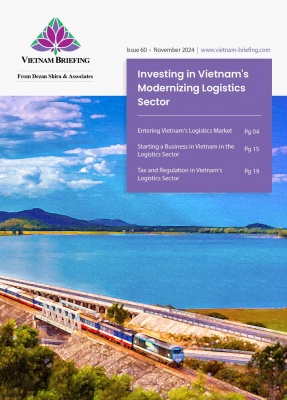Vietnam Implements Gender Equality Strategy but Challenges Remain
- Vietnam adopted the National Strategy on Gender Equality for the 2021-2030 period.
- The strategy aims to foster Vietnam’s gender equality and women entrepreneurship in the 2021-2030 period.
- Despite progress in narrowing the gender gap recently, Vietnam still faces challenges considering deep-rooted gender stereotypes and a ‘gendered structure’ economy.
The Vietnamese government has made it a priority to increase the participation of women in the workplace. To help facilitate these goals, the Vietnamese government has adopted the National Strategy on Gender Equality for the 2021-2030 period.
With women making up approximately 50 percent of the population, encouraging women entrepreneurship is central to this strategy. The plan also defines specific goals for Vietnam to promote gender equality in various areas, part of Vietnam’s Sustainable Development Goals (SDGs) by the UN. Some of the goals of the National Strategy on Gender Equality include:
- The rate of female directors or owners of businesses is expected to reach at least 27 percent by 2025 and 30 percent by 2030.
- The average time women spend doing unpaid housework will be reduced by 1.7 times by 2025 and 1.4 times by 2030 compared to that of men.
- By 2025, 80 percent of women suffering from domestic and gender-based violence will be given access to at least one of the basic support services, and 90 percent by 2030.
- The sex ratio at birth will be 111 boys per 100 girls by 2025 and 109 boys per 100 girls by 2030. The maternal mortality rate will drop to 42 per 100,000 live births by 2025 and below 42 per 100.000 live births by 2030.
- Gender and gender equality will be integrated into the curriculums at schools and pedagogical universities from 2025.
Since the plan’s approval in March 2021, the government has been executing new policies and initiatives to foster its implementation. On October 18, the Ministry proposed that the government give US$88 to COVID-19 infected pregnant women and women giving birth during the pandemic and US$45 to female medical workers and students participating in the fight against COVID-19.
The government also implemented flexible online training programs on digital technology for women-owned SMEs and has provided financial and non-financial services to vulnerable women.
Gender equality and women entrepreneurship
In Vietnam, there is a common notion of women being secondary earners while men being breadwinners, recorded in both rural and urban settings. This is known as a gendered structure economy. This involves the perception that women’s natural competency is mainly limited to housework and not in management and business. The gender earnings gap is estimated to be 29.5 percent, with 21.5 percent in urban areas and 35.2 percent in rural areas.
COVID-19 has also contributed to a reduction in working hours for women and the loss of jobs. Between the fourth quarter of 2019 and the same period in 2020, Vietnam’s women labor force participation rate fell from 76 percent to 73.8 percent.
Within the small and medium-sized enterprise (SME) sector in Vietnam, it is estimated that women-owned SMEs comprise 21 percent of formal enterprises. Data also highlights that women-owned businesses in Vietnam generally have similar average annual revenues compared to their male counterparts.
Due to the economic downturn caused by the pandemic, around half of women-owned SMEs were partially suspended or temporarily dissolved. Additionally, women-owned businesses reported a decline in revenues of 75 percent or greater in the first quarter of 2020, which was almost double that of their male counterparts.
The disparity in pay wages is the most visible. Women work similar hours to men and there is no significant difference in education levels, but they tend to be overrepresented in lower-paid segments of the labor market and in part-time work.
This reflects the structural discrimination in the workplace, constituting Vietnam’s gendered structure economy. This poses formal, social, and cultural barriers to women, hindering their participation in entrepreneurial activities and participation in the workplace.
However, in the past years, Vietnam has witnessed steady progress in women entrepreneurship as it ranked 10th in Asia and 25th globally in 2020 for the proportion of female participation in entrepreneurial activities.
Nevertheless, Vietnamese women tend to face greater vulnerability and disadvantages due to low levels of financial and digital literacy, lack of opportunities for capacity development, and discriminatory sociocultural norms.
Government initiatives to empower women in the business context
It should be noted that Vietnam’s investment climate for women is generally supportive. Vietnam has enacted various measures to help women in businesses, especially those in SMEs.
The Law on Support to SMEs (2017) outlined preferential measures for women-owned SMEs, specifically, in cases where SMEs are eligible for state support, priority should be given to women-owned SMEs or SMEs employing more women. Most recently, in September 2019, the government issued Circular 5 on training incentives for women-owned SMEs.
The previous National Strategy on Gender Equality for 2011-2020 has shown positive indications of the government’s efforts to empower women and built a foundation for the 2021-2030 strategy.
A goal was to make the literacy rate among women aged 15 and 60 be equal to that of men by 2020, with 94 percent of women in 14 provinces with disadvantaged economic conditions and 90 percent among ethnic minority areas. This target was successfully achieved under the strategy, showing increasing government efforts in fostering women in rural areas.
Clearly, even though many targets under the strategy were fulfilled, a number of policies and goals were under-achieved.
For example, the proportion of businesswomen only reached 24 percent while the target was 30 percent by 2015 and 35 percent upwards by 2020. The proportion of rural women workers under 45 years old who undergo professional and technical training only reached 17.4 percent by 2015, compared to the target of 25 percent.
On the bright side, the shortcomings and challenges help pave the way for the 2021-2030 strategy, indicating the need to ensure financial resources for gender equality and continue to address the under-achieved goals within the upcoming period.
Future implications
As UN Women praised Vietnam’s commitments to increase female representation in the workforce and politics particularly at local and provincial government levels, the strategy is expected to help Vietnam better achieve its national targets for women’s entrepreneurship, shaping a more sustainable and inclusive economy and society.
However, as the gender gap has been large and consistent throughout the years, challenges remain, demanding the government’s stringent efforts in the future.
About Us
Vietnam Briefing is produced by Dezan Shira & Associates. The firm assists foreign investors throughout Asia from offices across the world, including in Hanoi, Ho Chi Minh City, and Da Nang. Readers may write to vietnam@dezshira.com for more support on doing business in Vietnam.
We also maintain offices or have alliance partners assisting foreign investors in Indonesia, India, Singapore, The Philippines, Malaysia, Thailand, Italy, Germany, and the United States, in addition to practices in Bangladesh and Russia.
- Previous Article Annual Audit and Compliance in Vietnam: Get Ready for 2022 – Latest Issue of Vietnam Briefing Magazine
- Next Article Vietnam to Increase Production of Russia’s COVID-19 Vaccine































